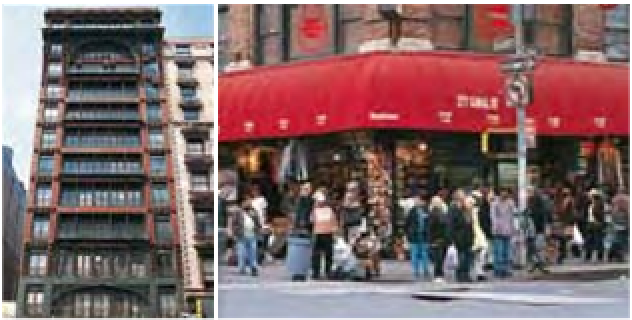Travel Reference
In-Depth Information
Haughwout Building
A cast-iron masterpiece, this
structure was built in 1857 to
house a fashionable china and
glassware emporium. The design
of colonnaded arches flanked by
taller Corinthian columns was
adapted from the façade of the
Sansovino Library in Venice. This
motif is repeated 92 times across
the front of the building. A 1995
restoration removed grime and
restored the elegant original pale
color. This building boasted the
first Otis safety elevator, an
innovation that made the
skyscraper possible.
d
488-492 Broadway at
Broome St
•
Map P4
TriBeCa's Movie Business
TriBeCa is known as Hollywood
East, and although much of its
movie business is behind the
scenes, many screenings take
place. Big name stars have been
sighted heading for the Grand
Screen Room at the TriBeCa
Grand Hotel
(see p177).
The TriBeCa Film Festival,
begun in May 2002, is a
further star-spotting event.
Canal Street
The end of SoHo, the begin-
ning of TriBeCa, and a world of its
own, no street better shows the
contrasts of New York.
Canal Street is crowded
with peddlers selling
fake Rolex watches and
Gucci bags, electronics
that may or may not be
new, and bargain stores
offering sneakers, jeans,
and flea-market finds.
Keep walking east
into Chinatown, and
the sidewalk goods
shift to vegetables and displays
of fish.
d
Map P3-4
“Little” Singer
Building
By the early 1900s,
cast iron was giving
way to steel-framed
brick and terra-cotta.
One notable example is
Ernest Flagg's “Little”
Singer Building (to
distinguish it from a taller tower
also built for Singer). Influenced
by Parisian architecture of the
period, it has a charming 12-
story façade and graceful
cast-iron balconies.
d
561-3
Broadway, between Prince & Spring sts
•
Map N4
Haughwout Building
Harrison Street
This rare group of Federal
townhouses, built between 1796
and 1828, did not exist as a row
until 1975, when the houses
Left
“Little” Singer Building
Right
Canal Street
100













